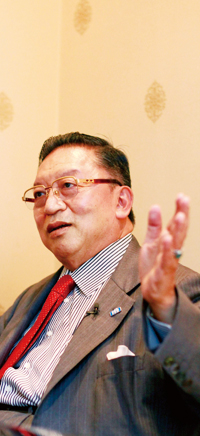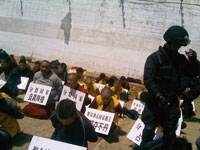The Future of Japan and China – Part 1
Japan is becoming a second Tibet
 Pema Gyalpo, professor at Toin University of Yokohama Graduate School, and author of “Last Objective: Emperor’s Execution – The Terrifying Facts about China’s ‘Directive to Liberate Japan’”
Pema Gyalpo, professor at Toin University of Yokohama Graduate School, and author of “Last Objective: Emperor’s Execution – The Terrifying Facts about China’s ‘Directive to Liberate Japan’”
Pema Gyalpo
Born 1953 in the Kham region of Tibet. Exiled to India in 1959, moved to Japan in 1965. Worked as first director of the Dalai Lama’s representation in the Asia Pacific region in the 1980 before he took on his present position. Also serves as advisor to the prime minister of the Kingdom of Bhutan. Publications include “Last Objective: Emperor’s Execution – The Terrifying Facts about China’s ‘Directive to Liberate Japan’” (published by Asuka Shinsha).
The authenticity of the “Directive to Liberate Japan” issued by the Chinese Communist Party has long been contested. When my book about the subject had just been published, my publisher got a phone call from a Chinese person claiming that its content was inaccurate. After this person had talked for a long time, he basically told my publisher that the Emperor mentioned in the “Directive to Liberate Japan” was the Emperor Showa rather than the present Emperor.
So actually, this Chinese person confirmed the authenticity of the “Liberation Directive”. (laughter)
Under the DPJ Administration, China is getting ever closer to executing the Emperor
If we compare the content of the Operational Directive with Japan’s present situation, it seems like China’s plan is making smooth progress. The current DPJ Administration is exactly the kind of administration China had in mind in the Directive.
In December 2009, after the DPJ took over from the LDP, the existing rule that applications for an audience with the Emperor had to be submitted at least one month in advance was hastily ousted, and Chinese Vice-President Xi Jinping received an audience with the Emperor. Ichiro Ozawa and 143 other democratic members of the Japanese Diet visited Beijing and met with President Hu Jintao and other Chinese government dignitaries. The members of the Japanese delegation had a frolic for taking pictures and shaking hands with them as if they were meeting stars.
Katsuya Okada, foreign minister at the time, gave instructions to the Emperor about what he was supposed to say. Hiroshi Nakai, head of the National Safety Commission at the time, hooted Prince Akishino and Princess Kiko, and it seemed like the execution of the Emperor, the third objective in China’s Operational Directive, was already around the corner.
More than five people gathering at any time will be punished with arrest

Armed police clamping down on monks, hanging signs around their necks stating their name and the crime they have been wrongly put upon (December 2011, Tibet Autonomous Region Sichuan). Photograph: AFP=Jiji
In 1950s, the Chinese People’s Liberation Army was after me. After running from them for over two years, I lost my country. Before the Chinese invaded Tibet, they sent their agents to the Tibetan temples and told them China was protecting Tibet from the imperialist ambitions of Europe and the U.S. They said “Tenda America”, meaning “America is the enemy of faith”, spreading wariness in Tibet towards all Western countries. The Chinese created an environment in Tibet that made it easy for their People’s Liberation Army to overrun the country without much resistance.
Then after the Tibetan Uprising in Lhasa in 1959, China seized all of Tibet, claimed it was “freeing the country from the fetters of feudalism”, and executed anybody enjoying any kind of regional authority including wealthy people, land owners, and monks – they killed anybody who belonged to the three highest social strata.
They drove stakes through the hands and feet of one of the most famous monks in the Khamu region, and then cut his stomach open. To another monk, the soldiers from the Liberation Army said: “If you can do miracles, show everyone and fly!” and kicked him down a high cliff. The Chinese thought that to spread communism in Tibet, they had to eradicate every last trace of religion, which they considered the opium of Tibet.
To this day, the people of Tibet are kept under constant surveillance, by security police during the day, and by armed police at night. If more than five people get together at any time of the day or night, this is considered an assembly, and they are arrested at the discretion of the local police. It happens daily. In this environment it is almost impossible to gather and demonstrate, but as Tibetans still want to draw the attention of the international community to their suffering, they resort to stark measures like pouring gasoline over their bodies and setting fire to themselves.
But the Chinese tell the media lies about these people, saying “She was crazy” or “He was up to his neck in debt” and completely distort the facts.
The will of the people is essential to protect the country
As a matter of fact, China is doing something very similar to Japan at the moment. China is planting a masochistic view of history and brainwashing us playing the victim. They are claiming that Japan was the sole aggressor during WWII, occupying China and slaying countless Chinese. Japanese politicians keep apologizing to China, but I believe this is largely a result of China’s psychological warfare. In this sense, China has already managed to smuggle its very own Trojan horse into Japan.
Not that I am trying to make excuses for China, but after all, using any means possible for the benefit of one’s own country is nothing unusual in the international community. So whether this is good or bad, as a one-party state, China can start moving towards its objectives as soon as it has decided what they are.
If things continue in this way, Japan will become a second Tibet, an autonomous region of China. To protect Japan, Japanese people need to amend the constitution and fortify the national security, but the most important thing is that they nurture the strong desire to protect their country.


















